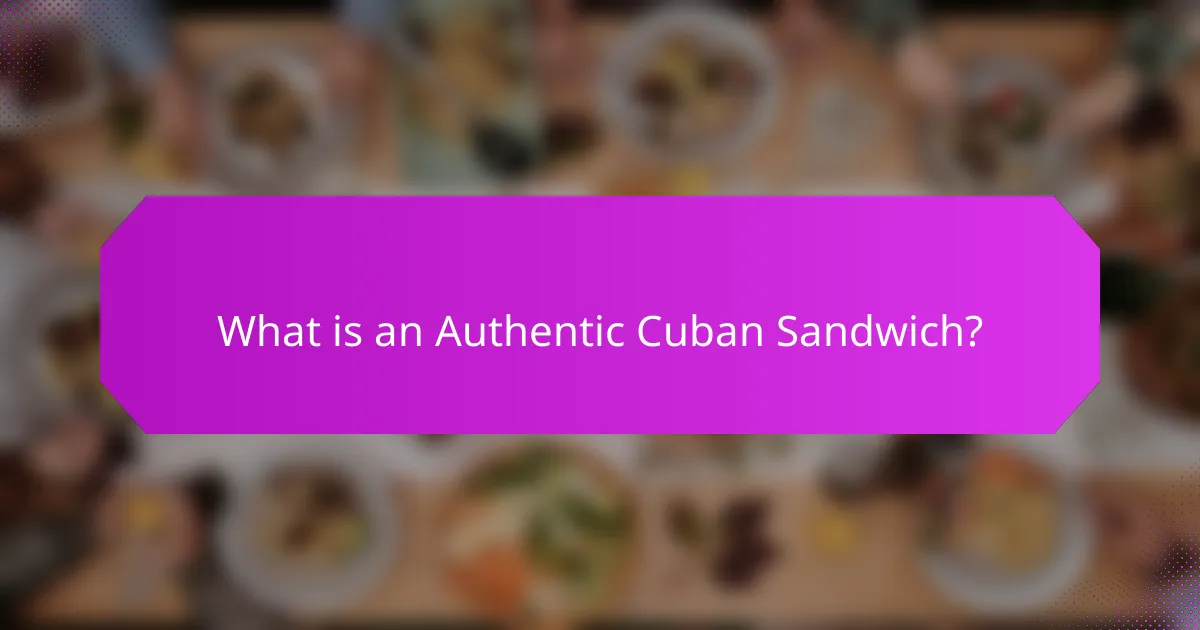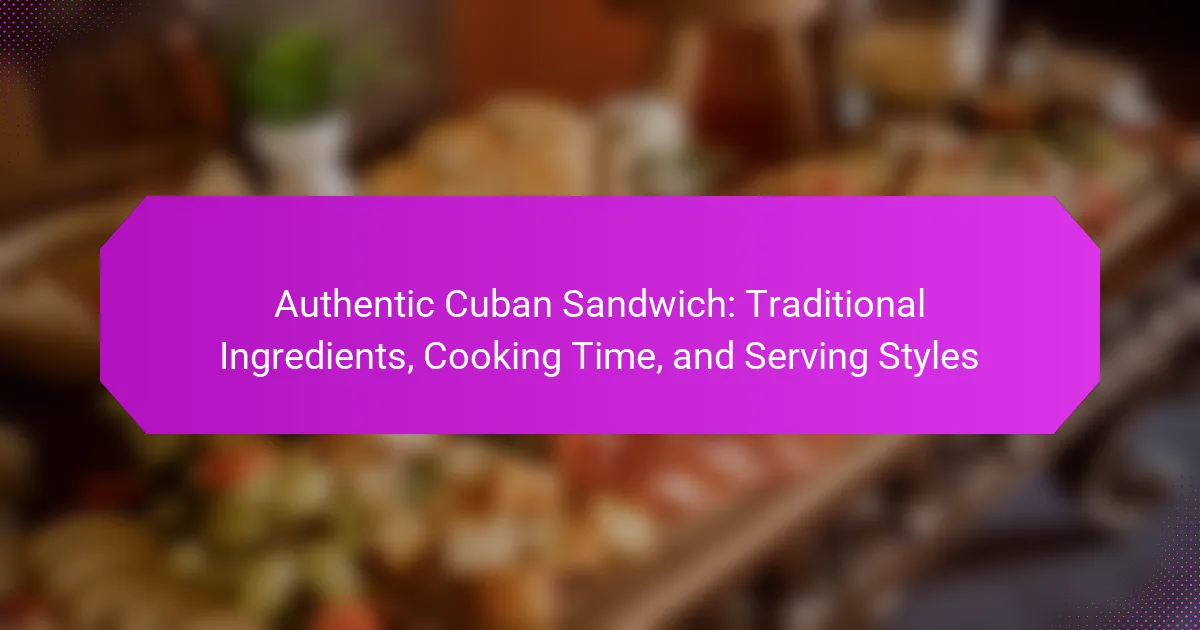An authentic Cuban sandwich is a pressed sandwich originating from Cuba, characterized by its use of specific ingredients including Cuban bread, roast pork, ham, Swiss cheese, pickles, and mustard. The preparation involves layering these components and pressing the sandwich to achieve a crispy exterior and melted cheese. This article explores the traditional ingredients, preparation methods, and serving styles of the Cuban sandwich, highlighting its historical roots in Key West and Tampa during the late 1800s. Additionally, tips for enhancing the sandwich experience through ingredient selection and cooking techniques are provided, ensuring an authentic taste reflective of Cuban culinary traditions.

What is an Authentic Cuban Sandwich?
An authentic Cuban sandwich is a pressed sandwich originating from Cuba. It typically consists of Cuban bread, roast pork, ham, Swiss cheese, pickles, and mustard. The sandwich is often pressed in a sandwich press to create a crispy exterior. This method of preparation enhances the flavors and textures of the ingredients. Cuban sandwiches are popular in Cuban-American communities, especially in Florida. The combination of savory meats and tangy pickles creates a distinctive taste. The sandwich’s roots can be traced back to the late 1800s in Key West and Tampa.
What are the historical origins of the Cuban Sandwich?
The Cuban Sandwich originated in Cuba in the late 19th century. It was influenced by Cuban immigrants who settled in Florida, particularly in Key West and Tampa. The sandwich typically consists of Cuban bread, roast pork, ham, Swiss cheese, pickles, and mustard. The combination reflects the culinary traditions of both Cuba and the Spanish immigrants in Florida. The sandwich gained popularity in the early 20th century, especially among Cuban workers in the cigar industry. Tampa claims to have the first Cuban sandwich, with variations emerging in other regions, particularly Miami. Today, it is recognized as a staple of Cuban cuisine and culture.
How did the Cuban Sandwich evolve over time?
The Cuban Sandwich evolved from a blend of Cuban and Spanish culinary traditions. It originated in Cuba in the late 19th century. Early versions featured Cuban bread, roasted pork, and ham. The sandwich gained popularity among Cuban immigrants in Florida, particularly in Key West and Tampa. In the early 20th century, it incorporated Swiss cheese and pickles. The Cuban Sandwich became a staple in Cuban-American culture. Its ingredients and preparation methods have varied regionally over time. Today, it is recognized as a symbol of Cuban cuisine.
What cultural influences shaped the Cuban Sandwich?
The Cuban Sandwich is shaped by diverse cultural influences, primarily Spanish, Cuban, and Cuban-American. Spanish immigrants introduced ingredients like chorizo and the concept of cured meats. Cuban culinary traditions contributed to the use of roasted pork and pickles. The incorporation of Swiss cheese and mustard reflects the influence of German immigrants. Cuban-Americans further popularized the sandwich in the United States, particularly in Florida. This fusion of flavors and techniques created a unique culinary identity. The Cuban Sandwich symbolizes the blending of cultures in Cuban history.
What are the key characteristics of an Authentic Cuban Sandwich?
An authentic Cuban sandwich features distinct layers of ingredients. It traditionally includes Cuban bread, which is a light and crispy white bread. The sandwich is filled with roasted pork, typically marinated in citrus and garlic. It also contains ham, Swiss cheese, pickles, and mustard.
The bread is pressed during cooking, creating a warm, toasted exterior. Authentic Cuban sandwiches are often served with a side of plantain chips or fries. The combination of flavors and textures defines its authenticity. This sandwich originated in Cuba and gained popularity in Cuban-American communities, particularly in Florida.
What makes a Cuban Sandwich ‘authentic’?
An authentic Cuban sandwich consists of specific traditional ingredients. The key components include Cuban bread, roasted pork, ham, Swiss cheese, pickles, and mustard. Each ingredient plays a critical role in achieving the sandwich’s unique flavor profile. Cuban bread is essential for its light, airy texture. Roasted pork, often marinated in citrus and garlic, provides a savory depth. Ham adds a contrasting sweetness. Swiss cheese melts perfectly, enhancing the overall taste. Pickles contribute a tangy crunch, while mustard adds a zesty kick. The sandwich is typically pressed to create a crispy exterior. This method of preparation is crucial for authenticity.
What are the typical ingredients used in an Authentic Cuban Sandwich?
An authentic Cuban sandwich typically includes Cuban bread, roast pork, ham, Swiss cheese, pickles, and mustard. Cuban bread is a key component, providing a soft yet crispy texture. Roast pork is marinated in a citrus-garlic sauce, enhancing its flavor. Ham adds a savory element to the sandwich. Swiss cheese melts beautifully, contributing creaminess. Pickles provide a tangy crunch, balancing the flavors. Mustard adds a zesty kick, tying the ingredients together. This combination of ingredients is essential to the traditional Cuban sandwich, widely recognized in Cuban cuisine.

What are the Traditional Ingredients of an Authentic Cuban Sandwich?
The traditional ingredients of an authentic Cuban sandwich include Cuban bread, roasted pork, ham, Swiss cheese, pickles, and mustard. Cuban bread is a key component, known for its soft interior and crispy crust. Roasted pork is marinated and slow-cooked, providing rich flavor. Ham adds a savory layer, while Swiss cheese melts beautifully when pressed. Pickles offer a tangy contrast to the meat and cheese. Mustard is spread on the bread for additional zest. Together, these ingredients create a distinctive taste that defines the Cuban sandwich.
What types of bread are used in a Cuban Sandwich?
Cuban sandwiches are traditionally made using Cuban bread. This bread is characterized by its soft texture and crispy crust. Cuban bread is similar to French or Italian bread but is distinct in its preparation and flavor. It is often baked in a long loaf shape. The dough typically includes lard, which contributes to its unique taste and texture. Other types of bread, such as bolillo or baguette, may be used as substitutes in some variations. However, authentic Cuban sandwiches primarily rely on Cuban bread for their signature profile.
How does the choice of bread affect the overall flavor?
The choice of bread significantly impacts the overall flavor of a Cuban sandwich. Cuban bread, characterized by its soft interior and crispy crust, complements the savory fillings. This bread has a subtle sweetness that enhances the taste of meats like roast pork and ham. Its texture allows it to hold up against moisture without becoming soggy. Other bread types, such as baguettes or ciabatta, may alter the sandwich’s flavor profile. These alternatives can introduce different textures and may not provide the same balance of flavors. A study by the Culinary Institute of America emphasizes that bread selection is crucial in achieving authentic flavor experiences in sandwiches.
Are there any traditional bread alternatives for a Cuban Sandwich?
Yes, there are traditional bread alternatives for a Cuban sandwich. Some alternatives include bolillo and telera bread. Bolillo is a crusty Mexican bread, while telera is a soft, slightly sweet bread commonly used in Mexican tortas. Both options can provide a similar texture and flavor profile to the traditional Cuban bread. These alternatives maintain the essence of the sandwich while offering slight variations.
What meats are essential for an Authentic Cuban Sandwich?
An authentic Cuban sandwich requires three essential meats: roasted pork, ham, and salami. Roasted pork, known as lechon, is marinated in a citrus-garlic sauce and slow-cooked for flavor. Ham adds a savory layer, typically a sweet or smoked variety. Salami, often Genoa salami, provides a unique taste that differentiates the Cuban sandwich from others. These meats are layered in a Cuban bread, contributing to the sandwich’s iconic profile. The combination of these meats is key to achieving the traditional taste that defines an authentic Cuban sandwich.
What role does roast pork play in the Cuban Sandwich?
Roast pork is a key ingredient in the Cuban Sandwich. It provides a rich, savory flavor that complements other components. The pork is typically marinated in a citrus-garlic mixture before roasting. This preparation enhances its tenderness and taste. The inclusion of roast pork differentiates the Cuban Sandwich from other sandwiches. Traditionally, it is layered with ham, Swiss cheese, pickles, and mustard. The combination creates a unique flavor profile. The roast pork is essential for authenticity in this classic Cuban dish.
How do ham and salami contribute to the flavor profile?
Ham and salami enhance the flavor profile of a Cuban sandwich through their distinct tastes. Ham provides a savory, slightly sweet flavor that balances other ingredients. It often adds a moist texture, enriching the overall mouthfeel. Salami contributes a robust, spicy kick that contrasts with the ham’s sweetness. The combination creates a complex flavor experience. Together, they offer a layered taste that is both rich and satisfying. This duality is essential in traditional Cuban sandwiches, making them more appealing. The choice of quality meats further intensifies these flavors, ensuring authenticity in every bite.
What condiments and additional ingredients enhance the Cuban Sandwich?
Pickles and mustard are essential condiments that enhance the Cuban sandwich. They provide a tangy flavor that complements the meats. Swiss cheese adds creaminess and richness. Roasted pork is a key protein that contributes to the sandwich’s heartiness. Ham adds additional flavor and texture. The use of Cuban bread gives the sandwich its distinctive character. Garlic and citrus marinade often flavor the meats, enhancing their taste. These ingredients combine to create a balanced and flavorful sandwich experience.
What types of mustard are commonly used?
Common types of mustard used include yellow mustard, Dijon mustard, and spicy brown mustard. Yellow mustard is often favored for its mild flavor and vibrant color. Dijon mustard offers a sharper taste and is popular in gourmet applications. Spicy brown mustard provides a robust flavor, often used in sandwiches. Each type complements different ingredients in a Cuban sandwich, enhancing the overall flavor profile.
How does pickles influence the taste of the sandwich?
Pickles enhance the taste of a sandwich by adding a tangy and crunchy texture. This contrast complements the richness of meats and cheeses. The acidity from pickles balances fatty flavors, creating a more harmonious bite. Additionally, pickles introduce a layer of complexity to the overall flavor profile. Their briny notes can elevate the taste experience, making each sandwich more enjoyable. This is particularly true in a Cuban sandwich, where pickles are a key ingredient. The use of pickles is rooted in traditional recipes, emphasizing their importance in achieving authentic flavor.

How is an Authentic Cuban Sandwich Prepared and Served?
An authentic Cuban sandwich is prepared by layering specific ingredients between Cuban bread. The traditional components include roasted pork, ham, Swiss cheese, pickles, and mustard. First, the Cuban bread is sliced lengthwise. Then, the roasted pork is placed on the bottom half. Next, slices of ham and Swiss cheese follow. Pickles are added for flavor, and mustard is spread on the top half of the bread.
After assembling the sandwich, it is pressed in a sandwich press or a plancha. This cooking method creates a crispy exterior while melting the cheese inside. The sandwich is typically served hot and cut diagonally for easy handling. Authentic Cuban sandwiches are known for their balance of savory and tangy flavors.
What is the traditional cooking method for a Cuban Sandwich?
The traditional cooking method for a Cuban sandwich involves pressing. A Cuban sandwich is typically made with Cuban bread filled with layers of roast pork, ham, Swiss cheese, pickles, and mustard. The sandwich is then placed in a sandwich press or a plancha. The pressing creates a crispy exterior while melting the cheese inside. This method enhances the flavors and textures of the ingredients. The Cuban sandwich is often served hot and is a staple in Cuban cuisine.
How does grilling impact the texture and flavor?
Grilling enhances the texture and flavor of food through high heat and direct contact with flames. The intense heat creates a Maillard reaction, which adds complexity and depth to the flavor. This reaction occurs when proteins and sugars react, resulting in browning and the development of savory notes. Grilling also imparts a smoky flavor due to the combustion of fats and juices that drip onto the heat source. The process typically results in a crispy exterior while maintaining a tender interior. For example, grilled meats often have a juicy inside contrasted with a charred outside. Additionally, grilling can caramelize sugars in vegetables, enhancing their sweetness. Overall, grilling transforms the sensory experience of food, making it more appealing.
What temperature should be used for grilling the sandwich?
The ideal temperature for grilling a sandwich is between 350°F to 400°F. This temperature range allows for even cooking and optimal melting of cheese. At 350°F, the bread will toast nicely without burning. At 400°F, the sandwich will achieve a crispy exterior while ensuring the interior is heated through. This method is commonly used for grilling various types of sandwiches, including the Cuban sandwich. Grilling at these temperatures ensures that the ingredients meld together perfectly, enhancing flavor and texture.
What are the common serving styles for a Cuban Sandwich?
Cuban sandwiches are commonly served as whole sandwiches or cut into halves. They are often pressed and toasted, creating a crispy exterior. Many diners enjoy them with pickles and mustard as standard condiments. Additionally, they may be accompanied by sides like plantain chips or fries. Some establishments offer them with a side of black beans or rice. The sandwich can be served on a plate or wrapped in paper for easy consumption. These serving styles reflect traditional Cuban dining practices.
How is a Cuban Sandwich typically presented in restaurants?
A Cuban sandwich is typically presented in restaurants as a pressed sandwich. It is made with Cuban bread, which is essential for its authenticity. The sandwich contains layers of roasted pork, ham, Swiss cheese, pickles, and mustard.
Restaurants often serve it cut diagonally for easy handling. The exterior is golden brown, showcasing the pressing technique. Many establishments accompany it with plantain chips or a side of pickles. This presentation highlights the sandwich’s traditional Cuban roots.
What sides are traditionally served with a Cuban Sandwich?
Traditionally, Cuban sandwiches are served with sides like plantain chips and black beans. Plantains are often sliced and fried, providing a crispy texture that complements the sandwich. Black beans are a staple in Cuban cuisine, often served seasoned with spices. These sides enhance the overall dining experience and reflect the flavors of Cuban culture. The combination of these sides with a Cuban sandwich is widely recognized and enjoyed.

What Tips Can Enhance Your Cuban Sandwich Experience?
To enhance your Cuban sandwich experience, focus on using authentic ingredients. Select high-quality Cuban bread, which is essential for the right texture. Use marinated pork, such as lechon asado, for rich flavor. Incorporate Swiss cheese, which melts beautifully and complements the meat. Add pickles for a tangy contrast that balances the richness. Spread yellow mustard for an additional layer of flavor. Press the sandwich using a plancha or heavy skillet to achieve a crispy exterior. Serve it hot to enjoy the best taste and texture. These tips ensure an authentic Cuban sandwich experience, reflecting traditional preparation methods.
What are some best practices for making an Authentic Cuban Sandwich at home?
To make an authentic Cuban sandwich at home, start with the right ingredients. Use Cuban bread, which is essential for the authentic texture. Layer the sandwich with roasted pork, ham, Swiss cheese, pickles, and mustard. Press the sandwich using a plancha or a heavy skillet to achieve a crispy exterior. Cook until the cheese melts and the bread is golden brown. Slice the sandwich diagonally for serving. Authentic Cuban sandwiches originated in Cuba and are popular in Florida. They are known for their combination of flavors and textures.
How can you customize your Cuban Sandwich without losing authenticity?
To customize your Cuban sandwich without losing authenticity, focus on traditional ingredients and preparation methods. Use the classic base of Cuban bread, which is essential for texture. Maintain the core fillings: roast pork, ham, Swiss cheese, pickles, and mustard. These ingredients define the sandwich’s identity.
Consider adding unique flavors while keeping the original essence. For example, you might include a slice of salami, popular in some Cuban communities. This addition respects regional variations while enhancing taste.
Alter cooking methods slightly, such as using a panini press instead of a traditional flat top. This modern method can still create the desired crispy exterior.
Ensure any additional ingredients complement rather than overpower the traditional flavors. Balancing new elements with classic ones preserves authenticity.
What common mistakes should you avoid when preparing a Cuban Sandwich?
Using the wrong bread is a common mistake when preparing a Cuban sandwich. Traditional Cuban bread is essential for the authentic flavor and texture. Overloading the sandwich with ingredients can also lead to a soggy result. A proper balance of meat, cheese, and pickles is crucial. Skipping the pressing step is another error; pressing helps meld the flavors. Not using enough mustard can result in a lack of flavor depth. Lastly, neglecting to toast the sandwich properly can leave it unappetizing. Each of these mistakes can compromise the authenticity and enjoyment of a Cuban sandwich.
Authentic Cuban Sandwich is a pressed sandwich originating from Cuba, characterized by its combination of Cuban bread, roast pork, ham, Swiss cheese, pickles, and mustard. The article explores the historical origins of the Cuban sandwich, its evolution over time, and the cultural influences that shaped its unique flavor profile. Key characteristics, traditional ingredients, preparation methods, and common serving styles are detailed, providing a comprehensive understanding of this iconic dish. Additionally, tips for enhancing the Cuban sandwich experience and common mistakes to avoid when preparing it at home are discussed, ensuring an authentic culinary experience.
